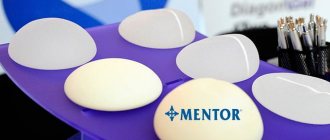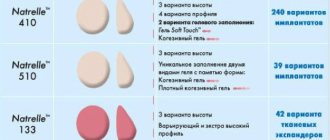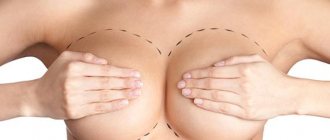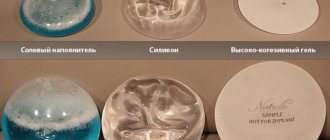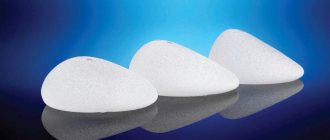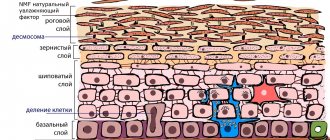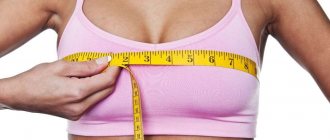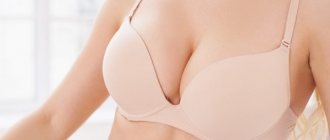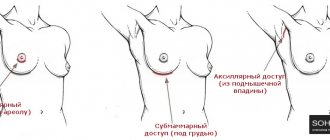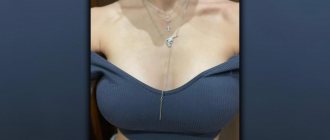7DAYS Radiant face cream-fluid ILLUMINATE ME ROSE GIRL/01Champagne, 50 ml
265 ₽ More details
7DAYS Body milk SUN PARTY SPARKLING STAR Sunscreen SPF 30 PA+++ with gold glitter, 150 ml
132 ₽ More details
7 Days
Mammoplasty is an operation that is leading in demand in the world. Silicone breasts are often necessary for medical reasons, but more often women who want to achieve external perfection come to the plastic surgeon’s table. When making your final decision, you should consider that this medical procedure has both advantages and disadvantages.
Breast implant shapes, tips for choosing
There are two main forms of breast implants in mammoplasty:
- round (hemispherical) - in such prostheses the highest point of the dome is located in the center;
- anatomical (teardrop-shaped) - they look like a drop, and are as close in outline as possible to the natural mammary gland.
It is impossible to unequivocally answer the question of which implant shape is better; this question is resolved individually.
Anatomical implants
The teardrop shape will add the necessary volume to the breasts and maintain natural contours. They are installed:
- if a woman’s areolas are located low (not in the center of the breast, but closer to the inframammary fold);
- for thin girls with a small layer of subcutaneous fat, so that after correction the breasts look natural.
Drop-shaped implants show less of themselves in bed and look natural when the mammary gland “spreads.” Among the disadvantages, one can note the fact that when the implant is rotated in an encapsular pocket, the defect will be more noticeable than with hemispherical implants.
Round implants
Round-shaped implants provide a push-up effect, increasing the volume of the gland in the upper pole. They look beautiful in the neckline area. Hemispherical endoprostheses are suitable for girls with developed chest muscles and a pronounced subcutaneous fat layer. Own soft tissues provide a smooth transition, without contouring. They are also suitable for female athletes, especially in power sports.
When such implants are rotated in the encapsular pocket, the defect will be invisible. If you choose the right profile and volume, then round dentures will look quite harmonious.
What is the implant filled with?
A viscous gel made of the same silicone, but having a different molecular structure. Modern gels do not have the disadvantages of previous generations, when the substance gradually flowed down the prosthesis under the influence of gravity. Prostheses from the world's leading manufacturers have a lifetime guarantee; they successfully withstand gravity. Some companies' products use two types of gel - a denser inner one and a softer outer one, hiding the edges of the dense layer. Thanks to this design, the breasts look and feel completely natural. After the end of the rehabilitation period, the woman has no restrictions on physical activity. She can engage in any kind of sports, including extreme ones - skydiving or ski jumping, when the body is suddenly shaken.
Breast implant profiles, selection tips
Profile is a value characterizing the ratio of the height of the projection of the implant to the width of its base. According to this characteristic, endoprostheses are divided into four types:
- Low (mini) - a low-height implant with a wide base. After endoprosthetics, the breasts will not protrude forward, so this projection during aesthetic mammoplasty is rarely chosen by women who seek breast enlargement. They are usually installed when correction of ptosis is required. Such prostheses are also suitable for thin men who want to give their chest relief and make it look more athletic.
- Medium (demi) - popular profile. It is chosen by women seeking naturalness. I recommend such implants for girls with size 1 and 2 breasts as a temporary option. In a few years, they can replace them with volumetric endoprostheses.
- Tall (full) is the best option for women who want to have high breasts..
- Extra high (corse) - refers to the highest sizes. After the installation of such implants, the breasts become very large and protrude as much as possible. The disadvantages of this profile include an unnatural appearance. Most often, the profile is chosen by women seeking attention. Among them are singers and actresses. In most cases, an ultra-high profile is performed during revision mammoplasty.
The visual enlargement of the breast after endoprosthetics depends on the profile.
Volume of breast implants, tips for choosing
When choosing the volume of endoprostheses, various anatomical indicators are taken into account, such as the woman’s height and weight, the width and shape of the chest, the initial size of the mammary glands, and tissue tension. The final volume after correction consists of the volume of glandular tissue and the implant, resulting in breast enlargement in patients. On average, it is believed that an increase in one size gives 100-200 ml of endoprosthesis volume, but the profile of the implant is also taken into account here. With a zero size, to get the first one, choose a volume of 200 ml, then the sizes go like this:
- from zero to second - 300 ml;
- from zero to third - 400 ml;
- from the first to the third - 300 ml;
- from the first to the fourth - 400 ml;
- from the second to the third - 200 ml;
- from the second to the fourth - 300 ml.
This diagram is conditional for a general understanding of the volume of endoprostheses. Typically, in the line of well-known manufacturers, the difference between different implants in volume is on average 30 ml, which makes it possible to more accurately select a model. However, a visible result gives a volume of 80 - 100 ml. The selection of implants includes not only volume, but also other characteristics, for example, the width of the mammary gland spot.
Trying on breasts
Before the operation, the plastic surgeon selects a new breast for the patient using a 3D computer modeling program that shows how the mammary glands will look after the operation. To do this, a series of stereo images are taken and transferred to a computer. Photo images are loaded into a special program, with which you can select the size and shape of the implant and choose the method of its installation. This allows you to evaluate the appearance of breasts with endoprostheses, avoiding mistakes.
Success in selecting implants depends not only on the computer program and the quality of the endoprostheses, but also on the qualifications of the doctor performing the operation. The most important thing is to find “your” doctor, such as plastic surgeon Sergei Morozov, who does mammoplasty in Moscow and St. Petersburg.
Return to list
Implant shell materials: advantages and disadvantages
The first breast correction implants were made of silicone and had a smooth surface. However, significant shortcomings were soon revealed in them: they easily shifted in the encapsular pocket and often caused contracture, that is, excessive growth of fibrous tissue, which deformed the prosthesis and caused a visible defect in the mammary gland.
Technologies improved and were replaced by textured shells. Their surface is rough, so they do not move, are tightly connected to the surrounding tissues, and are well fixed. Texture on the surface is achieved through irregularities.
Advanced shell materials include polyurethane coating. This shell has two layers: an inner silicone layer and an outer layer of polyurethane. Microgrooves on its surface are located asymmetrically and have different widths and depths. It is this feature that ensures reliable fixation of the implant and does not cause contractures. The two-layer shell is reliable and prevents sweating, that is, the gradual release of filler into the fabric. Implants with such a surface do not cause a “washboard” effect.
An implant with a polyurethane shell can only be installed subpectorally. Subfascial installation, that is, under the gland, of such implants is problematic. In some cases, the prosthesis is installed through the areola if the latter is of sufficient size. This feature of the shell can be considered a disadvantage. Another disadvantage of the polyurethane surface is that the breasts acquire mobility and a natural appearance only six months after the operation.
The latest “fashion” is nanotextured implants, the surface of which is matte to the touch. The peculiarity of these implants is their maximum closeness to the mammary gland in terms of softness. However, these implants are classified as non-ingrown and may sag over time, so it is recommended that they be installed in denser tissues.
Installation methods
The appearance of future breasts is also influenced by the method of their installation:
- Subglandular
- the prosthesis is installed directly under the gland tissue. The method is not used when installing large-volume implants, since the tissue thickness is not enough to cover the endoprosthesis. The operation does not interfere with subsequent sports activities; - Submuscular
- the implant is installed under the pectoralis major muscle. This method allows you to deeply “hide” the liner, which becomes invisible. The breasts become completely natural. The method is contraindicated for women involved in sports, since when muscles contract, the implants can move to the sides, forming an unsightly wide gap between the mammary glands; - Subfascial
- the endoprosthesis is installed under the fascia of the pectoralis major muscle. With this method, the liner does not move due to exercise, and the breasts look natural. But over time, if the breast tissue weakens, the implant may become dislodged.
Types of implants depending on the filler. Advantages and disadvantages
Today, four fillers are used, each with its own advantages and disadvantages.
Saline (saline)
The filler used is a 9% sodium chloride solution, known as saline. This concentration corresponds to the salt content in the blood and lymph, so even if the integrity of the composition is violated, it will not harm the tissues.
Such fillers are used in revision mammoplasty, that is, repeated breast augmentation. Endoprostheses have a built-in valve through which the cavity is filled after installation of the prosthesis. The advantages include the possibility of installing an implant through a small incision.
However, dentures with such a filler are less reliable.
Silicone
Cohesive silicone gel is used as a filler. This filler has been used for a long time and has been well studied. Such dentures can have different densities, from the softest - soft touch, to medium and high.
The advantages include their ability not to spread if the shell is damaged, as well as their high similarity to the glandular tissue of the breast in terms of tactile sensations.
Disadvantages include the need for large incisions when performing the operation. Damage to such an implant is difficult to detect; it can only be detected with an MRI.
Hydrogel (bioimplants)
These are modern biopolymer fillers, which, when the shell is damaged and the gel is released into the surrounding tissues, disintegrate into water, carbon dioxide and glucose: substances that are completely safe for the body.
They are similar in elasticity and consistency to the mammary gland and rarely cause capsular contracture.
Disadvantages include the lack of an FDA certificate issued by the US Drug and Medical Products Administration. This means that the experience of using such fillers has not been sufficiently studied and there is no strict quality control and safety during production.
Silicate (B-Lite)
The filler consists of gel and silicate beads. The advantages of such fillers include their low weight - they are one third lighter than saline or silicone prostheses. This makes it possible to install volumetric implants without increasing the load on the spine and back muscles. Lightweight prostheses installed submammarily reduce the risk of breast ptosis.
One of the disadvantages is that they have been poorly studied, since such fillers appeared recently and have not undergone long-term clinical trials. There is no data on how they will manifest themselves fifteen years after correction.
Still have questions? Ask them to a specialist
Plastic surgeon Vladimir Krugly will answer all your questions
Ask a Question
Comparison of artificial and natural breasts to the touch
By touch, you can identify artificial breasts if the prostheses are chosen incorrectly or are inserted in the axillary manner. If there is a deficiency of tissue, the silicone implant is visible, palpable, and folds form on it.
With the correct selection of methods and methods of implementation, size and quality of the filler, it is impossible to distinguish such breasts from real ones. Modern materials are not as dense as the cohesive gel of the first generations, so the mammary gland will not be unnaturally hard. Even if the breast is a third size or larger, the inserted implant, covered with the body’s own tissue, cannot be felt.
As for scars, they can only be palpated under the breast. In other cases of implantation - under the armpit or in the area of the areola of the nipples (no matter whether the breast is a second size or a fourth) - this is almost impossible to do.
Implant manufacturers
Breast endoprostheses are produced by many foreign companies and corporations that develop innovative technologies, improve implants, and have their own laboratories.
Eurosilicone implants
Features of Eurosilicone implants include an innovative shell of 13 layers with a thickness of 450 microns, which reliably protects against ruptures. Its Nusil barrier properties prevent the filler from sweating.
The brand's line includes the following types of endoprostheses:
- Paragel is hemispherical in shape with 139 modifications and two series Cristalline and Sculpturale. Below the surface of the shell is an impermeable liner.
- Aptex - anatomically shaped with cohesive gel filler and Nusil shell.
- Vertex - drop-shaped with an additional plate for reliable fixation. The plate is attached to the broad chest muscle.
- Komuro is a low-profile, teardrop-shaped prosthesis. This model is easy to install through an endoscopic incision in the armpit.
Each endoprosthesis is assigned a serial and identification number and entered into a database for subsequent monitoring. The company provides a lifetime warranty on its products.
Sebbin implants
The main difference between Sebbin brand implants is a double shell, the main one of which includes eight layers and an additional one that protects the filler from sweating. Endoprostheses are available with a smooth, macro- and micro-textured surface and three types of filler: soft (SoftTouch), classic and high density.
The implant is accompanied by a technological passport, which is signed by all specialists involved in its production. Laser marking is applied to the label, which is pasted into the patient’s chart after surgery.
Polytech implants
The brand’s line of implants includes 833 modifications with an outer shell of three types, four projections and four shapes.
Features of the brand’s implants include:
- Microthane® is a silicone shell with a micropolyurethane foam (MPPU) coating.
- DiagonGel® 4Two® - implants with two types of gel fillers that differ in density and breast tissue.
- B-Lite® - lightweight endoprostheses with silicate balls.
The Polytech® brand line includes three types of implant surfaces: micropolyurethane foam (Microthane®), macrotextured (POLYtxt®), microtextured (MESMO® sensitive™).
Each patient is given a lifetime guarantee for endoprostheses under the Polytech® “Implants of the Highest Quality” program.
In difficult cases, endoprostheses can be ordered according to individual sizes using 3D modeling using the “Custom Made Implants” program.
BellaGel implants
BellaGel prostheses are breast implants with a multi-layer durable shell that is resistant to perspiration of the filler. It is made from PDMS, an FDA-certified silicone. Endoprostheses with a smooth surface consist of five layers, textured ones - of six. The filler consists of 95% high-density cohesive gel. It is characterized by good “shape memory” - rapid restoration of contours after compression or pressure.
What is the outer layer of a silicone implant made of?
The capsule of a silicone breast implant has many layers - at least seven, thanks to which the internal gel cannot penetrate outside. The multilayer capsule resists ruptures, thanks to which operations proceed without complications. The surface of the capsule can be smooth or rough. The type of surface is chosen by the surgeon depending on the individual characteristics of the woman. Textured products with optimal pore size are more often used. Connective tissue easily penetrates these pores, forming a fibrous capsule around the foreign body. The pore size and surface roughness prevent the development of gross fibrosis and asymmetries.
